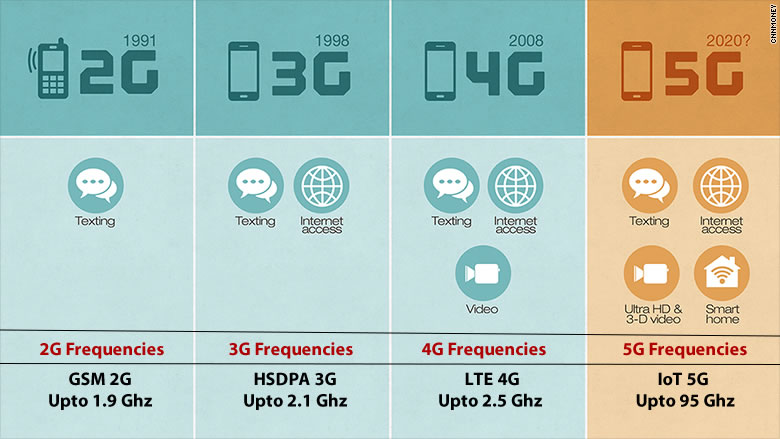However the speed and latency in early FR1 deployments using 5G NR software on 4G hardware non-standalone are only slightly better than new 4G systems estimated at 15 to 50 better. On the other hand the currently used 4G network operates on frequencies under 6 GHz.
 5g Network Uses Nearly Same Frequency As Weaponized Crowd Control Systems Rf Safe Emr Emf Safety Rf Mw Uva Uvb Uvc And Far Uvc
5g Network Uses Nearly Same Frequency As Weaponized Crowd Control Systems Rf Safe Emr Emf Safety Rf Mw Uva Uvb Uvc And Far Uvc
5G NR can include lower frequencies FR1 below 6 GHz and higher frequencies FR2 above 24 GHz.

5g vs 4g frequency. In fact 5G will use extremely high frequencies between 30 and 300GHz while 4G uses frequencies below 6GHz. A frequency of 600 MHz for example has lower bandwidth but because its not affected as easily by things like moisture in the air it doesnt lose power as quickly and is able to reach 5G phones and other 5G devices further away as well as better penetrate walls to provide indoor reception. While 4G networks were mostly designed for phones 5G networks were designed for much more flexible use replacing the need for many special-purpose networks.
A 5G network can even function as many separate networks all at the same time. 5G Ultra Wideband Verizons millimeter wavelength mmWave-based 5G operates at frequencies of about 28 GHz and 39GHz. What does this mean.
The range goes to an upper limit of up to 300 GHz. The radio spectrum is broken up into bands each with unique features as you move up into higher frequencies. Slices of the network can be tailored for a specific purpose and act as its own independent network.
Eventually 5G will also be launched on higher frequencies of between 30GHz and 300GHz known as millimetre wave or mmWave. TTI Transmission Time Interval 1 ms. Cat4 Cat1 Peak Data rate for Downlink.
What you can do with extra speed 5G is already up to 10 times faster than 4G in some places which is insanely cool. This is considerably higher than 4G networks which use about 700. Currently 5G is offered on the same mid-range radio frequencies as 3G and 4G below 6 Gigahertz or GHz and network providers plan to re-purpose old and out-of-use 2G spectrum to further expand 5G coverage.
1Gbps and higher as per need. 5G vs 4G. Verizon uses several spectrum bands for its 5G offerings.
2Mbps to 1Gbps. This is the fundamental difference between 5G and 4G. Right now 4G LTE technology is only capable of using lower frequency bands.
Theoretically 5G devices will able to reach peaks of 10 Gbps. For better understanding 1 Gigabit is made from 1000 Megabits. Carrier Bandwidth 14 MHz to 20 MHz 45G-Extension of 4G LTE.
4G speed test reveals that 5G tends to be about 100 times faster than 4G with speeds reaching 10 to 20 gigabits per second Gbps against 100 megabits per second Mbps offered by 4G. Thats a stark difference from the 100. 10 Mbps to 150 Mbps as per standard release Peak Data rate for Uplink.
For 5G the frequency spectrum of sub-6 GHz ranging between 450 MHz to 6 GHz and 24 GHz to 52 GHz are the frequency ranges of mmWave. As it stands all mobile networks use radio waves to transfer data but 5G will use higher frequencies than 4G to do this. LTE 3GPP Rel8 LTE Advanced 3GPP Rel12 Device categories.
For now T-Mobiles 5G network provides on average a 20 increase in download speeds compared to 4G LTE according to a company spokesperson. One underlying difference is 5Gs use of unique radio frequencies to achieve what 4G networks cannot. 5 Mbps to 50 Mbps as per standard release Used frequency BW.
Peak Data Rate. Currently 4G LTE is only able to use low-band frequencies up to 6GHz while the bands that 5G is capable of handling will range from 30GHz to. 4G uses frequencies below 6 GHz while some 5G networks use higher frequencies like around 30 GHz or more.
While the number for 5G is theoretically 20GB per second. The Fifth Generation network uses radio frequencies higher than 30 GHz. Regarding 5g vs 4g speeds comparison 5G can reach speeds that are 10 times faster than 4G LTE.
The maximum speed of 4G LTE 1GB per second. The aim with 5G is to hit 50Mbps as an average minimum however right now the minimum is quite a bit lower and the average sits around 57Mbps according to. This cool 5G technology is called network slicing.
New frequency bands and spectrum were also added with the arrival of 4G ranging from 600 MHz to 25 GHz. Right now it can only operate up to 6GHz whereas the radio bands that 5G will be able to handle will be anywhere. Varying 100 µs min to 4ms max Latency.
10 ms radio.
